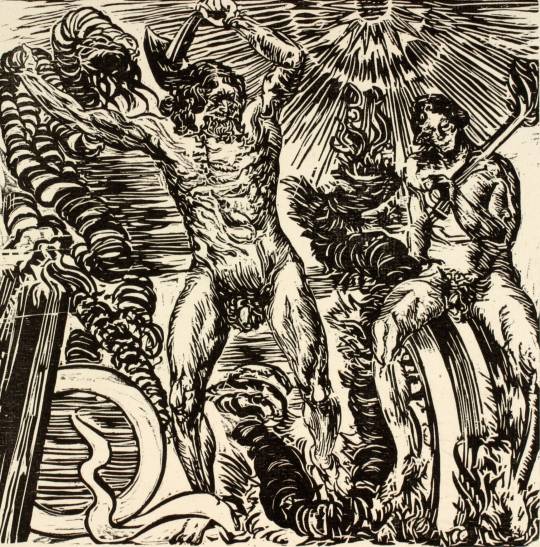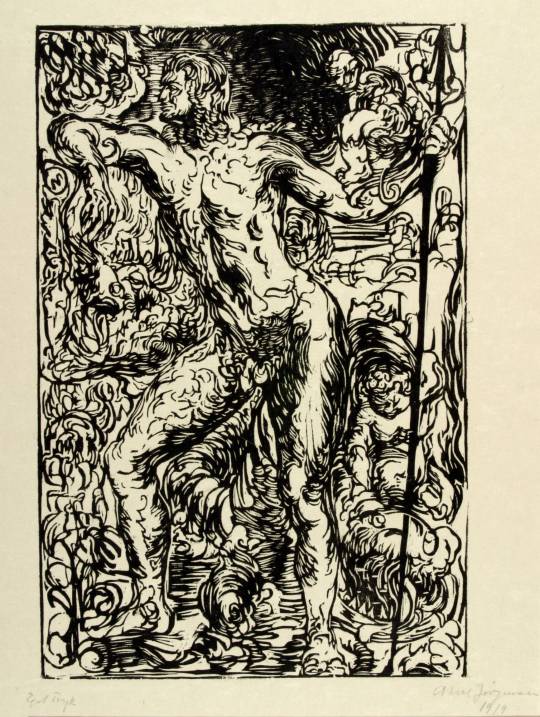#jorn nielsen
Explore tagged Tumblr posts
Photo

Town Hall (1963-65) in Fredericia, Denmark, by Halldor Gunnløgsson & Jørn Nielsen
144 notes
·
View notes
Text

Aksel Jørgensen (Feb 3., 1883 - 1957) was a Danish, largely autodidact artist, who still rose to the position of professor at the Royal Academy which he held for over 30 years. His students included Asger Jorn, Albert Mertz, Bjørn Wiinblad, Gerhard Sausmark, Ib Spang Olsen, Palle Nielsen, a.m.o.
Jørgensen mastered the woodcut technique and his first works depicted life in a working class neighborhood in Copenhagen whose drunkards, brawlers, prostitutes and entertainers he loved to sketch. Later he refined his woodcuts even more in an Art Nouveau style, as witnessed by this work - one of the illustrations for Oehlenschlæger’s poem, The Norse Gods.
Above: Thor og Midgårdsormen, 1919 - woodcut (SMK)
#art#danish artist#autodidact artist#aksel jørgensen#1910s#woodcut#norse mythology#thor#midgard serpent#danish royal academy of fine arts#asger jorn#albert mertz#bjørn wiinblad#gerhard sausmark#ib spang olsen#palle nielsen#art nouveau#oehlenschläger#norse gods#book illustration#smk#smkmuseum#statens museum for kunst
52 notes
·
View notes
Text




Asger Jorn
Biography
Asger Oluf Jorn was born the 3rd March 1914 and passed on the 1st May 1973. He was a founding member of the avant-garde movement COBRA and the Situationist International. He was born in Vejrum, in the northwest corner of Jutland, Denmark. He was the second oldest of six children. Both of his parents were teachers. His Christian father, Lars Peter Jørgensen died in a car crash when Asger was 12 years old. His mother, Maren, née Nielsen, was more liberal but nevertheless a deeply committed Christian. This early heavy religious influence had a negative effect on Asger who began progressively to inwardly rebel against it.
The Practice
Asger Oluf Jorn was a Danish painter, sculptor, ceramic artist, and author. Jorn became the subject of a number of oil paintings by the painter Martin Kaalund-Jørgensen, which encouraged Jorn to try his hand in this medium. Jorn also creates sculptures usually out of plaster and ceramic plates with murals on them.
Techniques
Jorn’s style is whimsical and bright. He creates funny and peculiar fantasy creatures in an abstract figurative world. In Jorn’s paintings there is a process of liberation of the painting, so it is not restrained in colour and form, but instead is spontaneous and creative. Jorn’s rough and abrasive use of the oil pants creates the texture and saturation that makes Jorn’s work so recognisable.
Context
Jorn was inspired by primitive art, children’s drawings and the Old Norse world. After he graduated from school the principal wrote a reference for him which said that he had attained 'an extraordinary rich personal development and maturity'. Jorn was also influenced by the syndicalist Christian Christensen, with whom he became close friends and who, Jorn was later to write, was to become a second father to him. In 1936 he travelled to Paris to become a student of Kandinsky. However, when he discovered that Kandinsky was barely able to sell his own paintings, Jorn decided to join Fernand Léger's Académie Contemporaine. It was during this period that he turned away from figurative painting and to abstract art.
Mémoires (or Memories) is an artist's book made by the Danish artist Asger Jorn in collaboration with the French artist and theorist Guy Debord. Created in 1959, it is the second of two collaborative books by the two men whilst they were both members of the Situationist International. It is one of my personal favourite pieces and is connected to the current focus in class. The artists book contains two layers of work. The first layer is a collage of text and images upcycled from old magazines and newspapers. Some are pieces of map from Paris and others are quotes or reproductions of old masters questions such as “'How do you feel about the world at the moment”. The next layer is printed in colour and splashed across the pages. They are unpredictable and disconnected throughout the pages, this contrasts to the black ink first layer and may represent the differing ideas and free flowing attitudes of the SI had in contrast to society. Some ink splashes also represent the inkblot test or test symbolising the psychological part of their theme, psychogeography.
Other pages deal with more personal themes, including a cartoon of the first showing of Jorn’s film Hurlements en Faveur de Sade and references to Dérive, which would become known as Situationist Drift, the habit of walking aimlessly through a city in an attempt to find its spirit. I am excited to try performing my own Dérive in the urban environment I will be taking inspiration from Asger Jorn when I carry out my walk, exploring locations near me. Detournement ('diversion' or 'disruption') is also throughout the book to throw the reader by creating collaged juxtapositions. Originally deriving from Dada, detournement would become a key situationist strategy.

0 notes
Text
Dane who built Maersk Broker into global force dies aged 66
Veteran Danish shipbroker Jorn Steen Nielsen succumbed to cancer on New Year's Day from Storage Containers https://www.tradewindsnews.com/incoming/1888697/dane-who-built-maersk-broker-into-global-force-dies-aged-66 via http://www.rssmix.com/
0 notes
Photo

Fishery and Shipping Museum (1966-68) in Esbjerg, Denmark, by Halldor Gunnløgsson & Jørn Nielsen
#1960s#museum#concrete#brick#brutalism#brutalist#architecture#denmark#architektura#halldor gunnlogsson#jorn nielsen
231 notes
·
View notes
Text

Otto Baagøe-Nielsen (August 21, 1924 - 2016) was a Danish artist, privately trained in Denmark in the 1940s, and a co-founder of the artists' group Spiralen in 1947. He showed with Surrealists such as Willhelm Freddie and abstract artists such as Asger Jorn. Baagøe-Nielsen traveled widely and lived in Greenland for many years.
Above: Untitled, 1959 - oil on canvas (Privately owned)
#art#danish artist#oil on canvas#danish painter#1950s#otto baagøe-nielsen#abstract art#surrealism#spiralen#wilhelm freddie#asger jorn
3 notes
·
View notes
Photo

Aksel Jørgensen (Feb 3., 1883 - 1957) was a Danish artist whose graphical works set the tone for years to come and influenced several generations of artists in Denmark. Jørgensen was largely autodidact but still rose to the position of professor at the Royal Academy which he held for over 30 years. His students included Asger Jorn, Albert Mertz, Bjørn Wiinblad, Gerhard Sausmark, Ib Spang Olsen, Palle Nielsen, a.m.o.
Jørgensen mastered the woodcut technique and his first works depicted life in a working class neighborhood in Copenhagen whose drunkards, brawlers, prostitutes and entertainers he loved to sketch. Later he refined his woodcuts even more in an Art Nouveau style, as witnessed by this work - one of the illustrations for Oehlenschlæger’s poem, The Norse Gods.
Above: Loke, 1919 - woodcut (SMK)
#art#danish artist#aksel jørgensen#1910s#woodcut#danish royal academy of fine arts#graphical arts#norse mythology#loki#loke#oehlenschläger#art nouveau#smkmuseum#smk#statens museum for kunst#asger jorn#albert mertz#bjørn wiinblad#gerhard sausmark#ib spang olsen#palle nielsen#social realism#working class artist#autodidact artist
5 notes
·
View notes